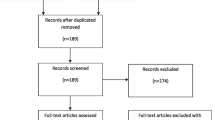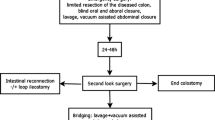Abstract
Purpose
Perforated diverticulitis with advanced generalized peritonitis is a life-threatening condition requiring emergency operation. To reduce the rate of colostomy formation, a new treatment algorithm with damage control operation, lavage, limited closure of perforation, abdominal vacuum-assisted closure (VAC; V.A.C.®), and second look to restore intestinal continuity was developed.
Methods
This algorithm allowed for three surgical procedures: primary anastomosis ± VAC in stable patients (group I), but damage control with lavage, limited resection of the diseased colonic segment, VAC and second-look operation with delayed anastomosis in patients with advanced peritonitis or septic shock (group II), and Hartmann procedure was done for social reasons in stable patients (group III)
Results
All 27 consecutive patients (16 women; median age 68 years) requiring emergency laparotomy for perforated diverticulitis (Hinchey III/IV) between October 2006 and September 2008 were prospectively enrolled in the study. No major complications were observed in group I (n = 6). Nine patients in group II (n = 15) had intestinal continuity restored during a second-look operation, of whom one patient developed anastomotic leakage. The median length of stay at intensive care unit was 5 days. Considering an overall mortality rate of 26% (n = 7), the rate of anastomosis in surviving patients was 70%.
Conclusions
Damage control with lavage, limited bowel resection, VAC, and scheduled second-look operation represents a feasible strategy in patients with perforated diverticulitis (Hinchey III and IV) to enhance sepsis control and improve rate of anastomosis.



Similar content being viewed by others
References
Chautems RC, Ambrosetti P, Ludwig A, Mermillod B, Morel P, Soravia C (2002) Long-term follow-up after first acute episode of sigmoid diverticulitis: is surgery mandatory?: a prospective study of 118 patients. Dis Colon Rectum 45:962–966
Chapman J, Davies M, Wolff B, Dozois E, Tessier D, Harrington J, Larson D (2005) Complicated diverticulitis: is it time to rethink the rules? Ann Surg 242:576–581
Nagorney DM, Adson MA, Pemberton JH (1985) Sigmoid diverticulitis with perforation and generalized peritonitis. Dis Colon Rectum 28:71–75
Salem L, Anaya DA, Roberts KE, Flum DR (2005) Hartmann’s colectomy and reversal in diverticulitis: a population-level assessment. Dis Colon Rectum 48:988–995
Jacobs DO (2007) Clinical practice. Diverticulitis. N Engl J Med 357:2057–2066
Janes SE, Meagher A, Frizelle FA (2006) Management of diverticulitis. BMJ 332:271–275
Krukowski ZH, Matheson NA (1984) Emergency surgery for diverticular disease complicated by generalized and faecal peritonitis: a review. Br J Surg 71:921–927
Constantinides VA, Tekkis PP, Athanasiou T, Aziz O, Purkayastha S, Remzi FH, Fazio VW, Aydin N, Darzi A, Senapati A (2006) Primary resection with anastomosis vs. Hartmann’s procedure in nonelective surgery for acute colonic diverticulitis: a systematic review. Dis Colon Rectum 49:966–981
Ferzoco LB, Raptopoulos V, Silen W (1998) Acute diverticulitis. N Engl J Med 338:1521–1526
Salem L, Flum DR (2004) Primary anastomosis or Hartmann’s procedure for patients with diverticular peritonitis? A systematic review. Dis Colon Rectum 47:1953–1964
Seetharam S, Paige J, Horgan PG (2003) Impact of socioeconomic deprivation and primary pathology on rate of reversal of Hartmann’s procedure. Am J Surg 186:154–157
Bordeianou L, Hodin R (2007) Controversies in the surgical management of sigmoid diverticulitis. J Gastrointest Surg 11:542–548
Constantinides VA, Heriot A, Remzi F, Darzi A, Senapati A, Fazio VW, Tekkis PP (2007) Operative strategies for diverticular peritonitis: a decision analysis between primary resection and anastomosis versus Hartmann’s procedures. Ann Surg 245:94–103
Vermeulen J, Akkersdijk GP, Gosselink MP, Hop WC, Mannaerts GH, van der HE C, PP WWF, Lange JF (2007) Outcome after emergency surgery for acute perforated diverticulitis in 200 cases. Dig Surg 24:361–366
Chouillard E, Maggiori L, Ata T, Jarbaoui S, Rivkine E, Benhaim L, Ghiles E, Etienne JC, Fingerhut A (2007) Laparoscopic two-stage left colonic resection for patients with peritonitis caused by acute diverticulitis. Dis Colon Rectum 50:1157–1163
Taylor CJ, Layani L, Ghusn MA, White SI (2006) Perforated diverticulitis managed by laparoscopic lavage. ANZ J Surg 76:962–965
Favuzza J, Friel JC, Kelly JJ, Perugini R, Counihan TC (2009) Benefits of peritoneal lavage for complicated sigmoid diverticulitis. Int J Colorectal Dis 24:797–801
Franklin ME Jr, Dorman JP, Jacobs M, Plasencia G (1997) Is laparoscopic surgery applicable to complicated colonic diverticular disease? Surg Endosc 11:1021–1025
Frattini J, Longo WE (2006) Diagnosis and treatment of chronic and recurrent diverticulitis. J Clin Gastroenterol 40:S145–S149
Kohler L, Sauerland S, Neugebauer E (1999) Diagnosis and treatment of diverticular disease: results of a consensus development conference. The Scientific Committee of the European Association for Endoscopic Surgery. Surg Endosc 13:430–436
Barker DE, Kaufman HJ, Smith LA, Ciraulo DL, Richart CL, Burns RP (2000) Vacuum pack technique of temporary abdominal closure: a 7-year experience with 112 patients. J Trauma 48:201–206
Perez D, Wildi S, Demartines N, Bramkamp M, Koehler C, Clavien PA (2007) Prospective evaluation of vacuum-assisted closure in abdominal compartment syndrome and severe abdominal sepsis. J Am Coll Surg 205:586–592
Miller PR, Meredith JW, Johnson JC, Chang MC (2004) Prospective evaluation of vacuum-assisted fascial closure after open abdomen: planned ventral hernia rate is substantially reduced. Ann Surg 239:608–614
Cipolla J, Stawicki SP, Hoff WS, McQuay N, Hoey BA, Wainwright G, Grossman MD (2005) A proposed algorithm for managing the open abdomen. Am Surg 71:202–207
Teixeira PG, Salim A, Inaba K, Brown C, Browder T, Margulies D, Demetriades D (2008) A prospective look at the current state of open abdomens. Am Surg 74:891–897
Hinchey EJ, Schaal PG, Richards GK (1978) Treatment of perforated diverticular disease of the colon. Adv Surg 12:85–109
Linder MM, Wacha H, Feldmann U, Wesch G, Streifensand RA, Gundlach E (1987) The Mannheim peritonitis index. An instrument for the intraoperative prognosis of peritonitis. Chirurg 58:84–92
Ansari MZ, Collopy BT, Hart WG, Carson NJ, Chandraraj EJ (2000) In-hospital mortality and associated complications after bowel surgery in Victorian public hospitals. Aust N Z J Surg 70:6–10
Komen N, Dijk JW, Lalmahomed Z, Klop K, Hop W, Kleinrensink GJ, Jeekel H, Schouten WR, Lange JF (2009) After-hours colorectal surgery: a risk factor for anastomotic leakage. Int J Colorectal Dis 24:789–795
Schwesinger WH, Page CP, Gaskill HV III, Steward RM, Chopra S, Strodel WE, Sirinek KR (2000) Operative management of diverticular emergencies: strategies and outcomes. Arch Surg 135:558–562
Author information
Authors and Affiliations
Corresponding author
Additional information
Conception, acquisition of data, analysis, and interpretation of data were carried out by Alexander Perathoner, Alexander Klaus, and Reinhold Kafka-Ritsch. Drafting and revision of the article were made by Alexander Perathoner, Alexander Klaus, Gilbert Mühlmann, Michael Oberwalder, Raimund Margreiter, and Reinhold Kafka-Ritsch.
Rights and permissions
About this article
Cite this article
Perathoner, A., Klaus, A., Mühlmann, G. et al. Damage control with abdominal vacuum therapy (VAC) to manage perforated diverticulitis with advanced generalized peritonitis—a proof of concept. Int J Colorectal Dis 25, 767–774 (2010). https://doi.org/10.1007/s00384-010-0887-8
Accepted:
Published:
Issue Date:
DOI: https://doi.org/10.1007/s00384-010-0887-8




